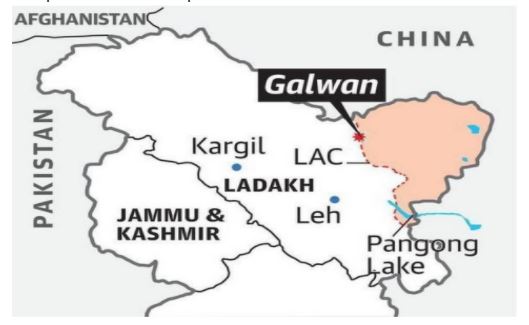GS 2, International Relations, TLP-UPSC Mains Answer Writing
1. What are your views on the recent military standoff between India and China? What is the geo-strategic background of the standoff? Examine.
भारत और चीन के बीच हालिया सैन्य गतिरोध पर आपके विचार क्या हैं? गतिरोध की भू–रणनीतिक पृष्ठभूमि क्या है? जाँच करें।
Demand of the question:
It expects candidates to express their views on the recent military standoff between India and China. It also expects to probe deeper in to details of the geo-strategic background of the standoff.
Introduction:
India and China are demographically two very unique countries, only two with billion plus (population) categories. Global order is observing parallel but differential rise of two countries with unprecedented disagreements over border disputes due to the expansionist policy of China based on its ancestral claims.
Body:
Indian and Chinese troops have engaged in aggressive melee, face-offs and skirmishes at locations along the LAC in Galwan valley, in eastern Ladakh including near the disputed Pangong Lake in Ladakh and the Tibet Autonomous Region, and near the border between Sikkim and the Tibet Autonomous Region.
Views on Military standoff between India and China:
- It is part of China’s ‘nibble and negotiate policy’. Their aim is to ensure that India does not build infrastructure along the LAC. It is their way of attaining a political goal with military might, while gaining more territory in the process.
- China views India’s assertions regarding Gilgit-Baltistan, as an implicit attack on the China-Pakistan Economic Corridor (CPEC), China’s flagship programme. This view of China contradicts India’s sovereignty claim and threatens security infrastructure.
- The resulted casualties across the LAC are not acceptable as Indian soldiers martyred along LAC due to China’s wrongful approach to gain access of the Indian territory.
- The escalated tensions across LAC have affected India’s trade relations with China as India’s trade deficit with China stands at $48.66 billion in 2019-20.
- In turn it also affected Foreign Direct Investment (FDI) in India, as FDI from China in India has dipped to $163.78 million in 2019-20 from $229 million in 2018-19.
- Citing the “emergent nature of threats” from mobile applications, including popular ones of Chinese origin such as TikTok, ShareIt, UCBrowser, and Weibo, the government has banned 59 apps. The app ban has resulted in loss of invetment from Chinese investors in India.
- Hardly any country in Asia is willing to openly confront China, and side with India, due to China’s strong economic ties with other nations.
- Recent events, suggest that escalations are highly possible. Both sides have substantial—and growing—military deployments along a mostly disputed border. This in turn has affected the peace across the border and affected lives of people who are living along the border areas.
- However, through recent skirmishes along the LAC India has shown to China that it will not take step back when it comes to securing its sovereignty.
Geo-strategic background of the standoff:
- The Indian and Chinese armies are engaged in the standoff in Pangong Tso, Galwan Valley, Demchok and Daulat Beg Oldie in eastern Ladakh. Following figure 1 represents the Disputed area.

figure 1
- A sizable number of Chinese Army personnel even transgressed into the Indian side of the de-facto border in several areas including Pangong Tso.
- The actions on the northern bank of Pangong Tso are not just for territorial gains on land, but enhanced domination of the resource-rich lake.
- The stand-off at Ladakh’s Galwan Valley has escalated in due to the infrastructure projects that India has undertaken in the recent years. India is building a strategic road through the Galwan Valley – close to China – connecting the region to an airstrip.
- China is opposed to any Indian construction in the area. In 1962, a stand-off in the Galwan area was one of the biggest flashpoints of the 1962 war.
- The border, or Line of Actual Control, is not demarcated, and China and India have differing ideas of where it should be located, leading to regular border “transgressions.” Often these don’t escalate tensions; a serious border standoff like the current one is less frequent, though this is the fourth since 2013.
- Both countries’ troops have patrolled this region for decades, as the contested 2,200-mile border is a long-standing subject of competing claims and tensions, including a brief war in 1962.
Steps to resolve the issue:
- Clarification on LAC: India should take the initiative to insist on a timely and early clarification of the LAC. Pockets of difference of alignment as perceived by each side have to be clearly identified and these areas demilitarised by both sides through joint agreement pending a settlement of the boundary.
- Scaling down of military contact: India must stand resolute and firm in the defence of territory in all four sectors of the border. Contacts between the two militaries through joint exercises and exchanges of visits of senior Commanders should be scaled down for the foreseeable future.
- Strategic communication: The responsibility of effective strategic communication too rests with political leadership. It is important to perceive the signals of transgressions on a serious note and adopt adequate strategy with clear instructions for forces.
Conclusion:
As our Foreign minister has said that, “Reaching an understanding with China is a big challenge”; we need find out more ways to open talks with China regarding border issues and Devolving a comprehensive China strategy with strong political direction, mature deliberation and coherence are keys to handling the any escalating situation in future.














